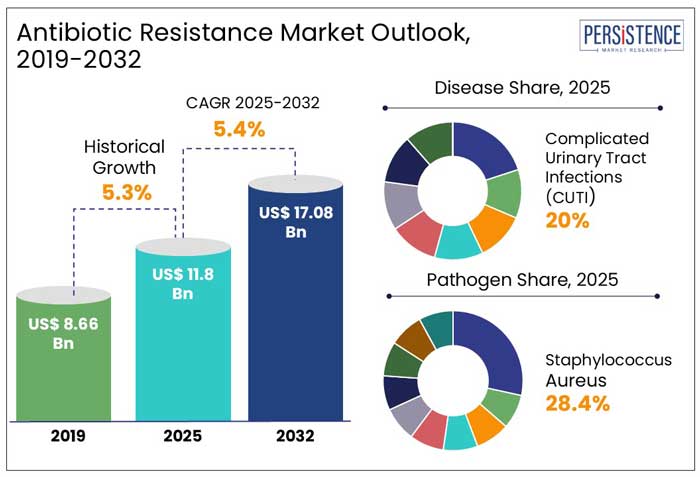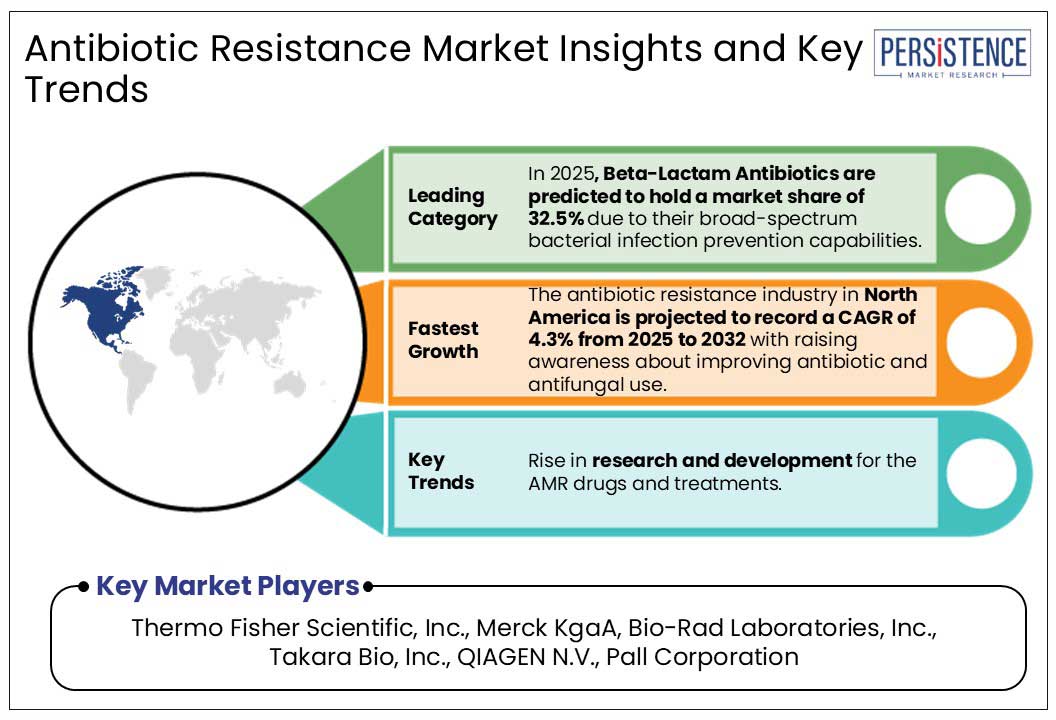ID: PMRREP27895| 188 Pages | 17 Feb 2025 | Format: PDF, Excel, PPT* | Healthcare

The global antibiotic resistance market size is anticipated to rise from US$ 11.8 Bn in 2025 to US$ 17.08 Bn by 2032. It is projected to witness a CAGR of 5.4% from 2025 to 2032.
As per Persistence Market Research, antibiotic-resistant infections are pushing market growth due to the increasing burden of these infections, which pose a significant public health threat.
The World Health Organization (WHO) has identified antibiotic-resistant bacteria as a major global health threat. A recent discovery by Adela Melcrova at the University of Groningen reveals that the new antibiotic AMC-109 disrupts bacterial cell membrane organization, offering new avenues for future treatments and drug development.

Key Highlights of the Antibiotic Resistance Market
|
Global Market Attributes |
Key Insights |
|
Antibiotic Resistance Market Size (2025E) |
US$ 11.8 Bn |
|
Market Value Forecast (2032F) |
US$ 17.08 Bn |
|
Projected Growth (CAGR 2025 to 2032) |
5.4% |
|
Historical Market Growth (CAGR 2019 to 2024) |
5.3% |
Research to Tackle Antimicrobial Resistance Gained Impetus Amid the Pandemic
The global antibiotic resistance industry witnessed a CAGR of 5.3% in the historical period between 2019 and 2024. The health and environment of humans and animals are increasingly at risk from antimicrobial resistance (AMR) in the midst of the worldwide pandemic.
To tackle the problem in 2022, the Quadripartite, which includes organizations like FAO, UNEP, WHO, and WOAH are anticipated to cooperating.
When bacteria, viruses, fungi, and parasites stop responding to antimicrobial treatments, it's known as AMR, which makes treating illnesses challenging or impossible. This leads to a rise in disease transmission, severe sickness, and mortality.
Quadripartite launches World Antimicrobial Awareness Week to promote "Preventing Antimicrobial Resistance Together" among stakeholders, aiming to build consensus on global AMR goals, understand possibilities, and implement multi-stakeholder initiatives.
Government Backed Research Efforts to Boost the Market through 2032
In the estimated timeframe from 2025 to 2032, the global market for antibiotic resistances is likely to showcase a CAGR of 5.4%. Since the formation of the Quadripartite, the sub-branch of WHO, have launched a Working Group on Youth Engagement for Antimicrobial Resistance.
The group is projected to guide efforts to raise awareness and involve young people in global AMR action, post-pandemic. AMR occurs when bacteria, viruses, fungi, and parasites no longer respond to antimicrobial agents, increasing the risk of disease spread and severe illness.
The initiatives taken by the authoritative bodies to tackle AMR and other diseases are estimated to present lucrative opportunities for research and development to pharma industry players in the upcoming period.
Growth Drivers
Rising Demand for AMR Solutions Amid Drug-Resistant Infection Surge
The demand for antimicrobial resistance is growing due to drug-resistant illnesses, excessive antibiotic usage, and a dearth of novel therapies.
Pharmaceutical companies like GSK, Pfizer, and Merck are investing in the development of novel antibiotics and antimicrobial therapies. For instance,
Antibiotic stewardship initiatives, AI-driven medication discovery, and quick diagnostic testing are anticipated to propel market growth by offering efficient remedies for infections that are resistant to therapy.
Stringent Regulations and Healthcare Expenses Stall Antibiotic Market Growth
The development of new antibiotics faces significant challenges due to strict government regulations, lengthy approval processes, and high costs.
Creating a new antibiotic typically requires ten to fifteen years and costs around US$ 1.5 Bn. Low profit margins deter pharmaceutical companies from investing in this area, despite the urgent need.
Rigorous clinical trial requirements from the U.S. FDA and European Medicines Agency contribute to delayed approvals. In 2022, GSK and Pfizer pointed out the financial risks linked to antibiotic research, leading to fewer new drug discoveries.
Consequently, many biotech firms have exited the antimicrobial resistance market, as highlighted by the 2021 bankruptcy of Achaogen, a company specializing in antibiotics, which further emphasized the market's instability.
Research and Development Investment Drives Innovation in AMR Solutions
The rising investment in research and development of novel antibiotic compounds and alternative treatments is expanding market opportunities in the fight against antimicrobial resistance.
The research aims to create a bacteriophage-based treatment for AMR E. coli strains, offering an innovative alternative to traditional antibiotics. Bacteriophage therapy, which uses viruses to kill drug-resistant bacteria, is gaining popularity as a promising AMR solution, benefiting the global AMR market.
Pathogen Insights
Staphylococcus Aureus Leads the Charge in the Battle Against AMR
In 2025, Staphylococcus aureus-targeting antibiotics are projected to dominate the market, holding a 28.4% share, due to the high prevalence of Methicillin-resistant Staphylococcus aureus (MRSA) infections. Major pharmaceutical players are actively working on new drug development.
Clinical studies concluded in November 2023 showed that GSK's new oral antibiotic, gepotidacin, was highly effective against drug-resistant Neisseria gonorrhoeae.
Along with that, Entasis Therapeutics, a subsidiary of Innoviva, gained FDA approval for Xacduro in April 2023, targeting carbapenem-resistant Acinetobacter baumannii, indicating a growing global investment in advanced antibiotic discovery and bacteriophage therapy.
Drug Class Insights
Beta-Lactam Antibiotics Power the Next Generation of Infection Control
In 2025, Beta-Lactam Antibiotics are projected to hold the largest market share in the AMR drug market, accounting for 32.5%, driven by their broad-spectrum efficacy against bacterial infections. These include penicillins, carbapenems, and monobactams, which remain first-line treatments despite rising resistance concerns.
Major pharmaceutical companies such as Pfizer, Merck, and GSK continue to invest in next-generation beta-lactam inhibitors to combat drug-resistant pathogens.
Meanwhile, Combination Therapies are expected to gain momentum, capturing 26.8% of the market, as they enhance drug efficacy and reduce resistance development. These therapies, combining beta-lactam antibiotics with β-lactamase inhibitors (e.g., Zavicefta by Pfizer), are critical in treating multi-drug-resistant infections.

Rise in Treatments for AMR in North America Present Novel Prospects
In 2025, North America is estimated to account for around 36% of the global market, with antibiotic resistance being a significant issue. The region is projected to showcase a CAGR of 4.3% in the forecast period.
The CDC conducts U.S. Antibiotic Awareness Week, aimed at raising awareness about improving antibiotic and antifungal use and reducing AR development.
The reimbursement policy on cancer treatment and the growing adult population has increased government involvement in raising awareness of antibiotic resistance, bolstering the market value on a global scale.
Europe Boost the Advancement in Clinical Management for Different Diseases
Europe is expected to cultivate in the global AMR market, accounting for 18.7% in 2025. The market is expected to record a CAGR of 4.9% from 2025 to 2032, driven by rising drug-resistant infections and the need for novel treatments for diseases like cUTI, cIAI, HABP/VABP, and others.
Pharma players in Europe are making investments in combating AMR, with regulatory bodies like the European Medicines Agency (EMA) fast-tracking approvals for new antibiotics.
Superbug Crisis in Asia Pacific Boost Pharma Innovations
Asia Pacific is set to play a crucial role in boosting global drug production, particularly in emerging economies such as China and India.
In 2021, 1.14 million fatalities were attributed to antibiotic-resistant microorganisms, commonly known as superbugs, with India being the most affected country.
Novel medications such as Zaynich and Enmetazobactam can combat such infections and preserve last-resort therapies. Companies like Sun Pharmaceutical and Cipla are expanding their antimicrobial drug portfolios to address this crisis.
Drug development is being accelerated by China's government-funded research and India's growing pharmaceutical manufacturing capabilities, positioning Asia Pacific for a sizable market share on a global scale.
Key players in the global antibiotic resistance market are expected to significantly enhance their research and development initiatives. A growing number of organizations are anticipated to introduce innovative drugs and treatment options, supported by government initiatives and private sector investments.
In order to strengthen their market positions, these companies are likely to adopt a variety of strategies, including mergers and acquisitions, intensive research and development efforts, the launch of new products, and expansion into new geographical markets. This proactive approach aims to address the urgent challenges posed by antibiotic resistance and improve healthcare outcomes worldwide. The global market is expected to witness the entry of several start-up companies with unique product portfolios in the forthcoming decade.
Key Industry Developments
By Drug Class
By Pathogen
By Disease
By Mechanism of Action
By Distribution Channel
By Region
The market is set to reach US$ 11.8 Bn in 2025.
Antimicrobial resistance mechanisms can be categorized into four main types: limiting drug uptake, modifying drug targets, inactivating drugs, and active drug efflux.
Thermo Fisher Scientific, Inc., Merck KgaA, Bio-Rad Laboratories, Inc., Takara Bio, Inc., and QIAGEN N.V. are a few leading players.
The industry is estimated to rise at a CAGR of 5.4% through 2032.
North America is projected to hold the largest share of the industry in 2025.
|
Report Attributes |
Details |
|
Historical Data/Actuals |
2019 - 2024 |
|
Forecast Period |
2025 - 2032 |
|
Market Analysis Units |
Value: US$ Bn/Mn, Volume: As applicable |
|
Geographical Coverage |
|
|
Segmental Coverage |
|
|
Competitive Analysis |
|
|
Report Highlights |
|
|
Customization and Pricing |
Available upon request |
Delivery Timelines
For more information on this report and its delivery timelines please get in touch with our sales team.
About Author